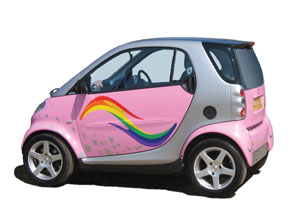Module 1—Motion
 Explore
Explore
Displacement Versus Distance

© drknuth/BigStockPhoto
The personalized Smart car is painted pink and adorned with a rainbow.
When you travel in a Smart car, you experience a change in position. The change in position is defined by the vector quantity displacement. Displacement is a vector that points from the initial position to the final position, regardless of the path (distance) over which the object moved.
 Watch and Listen
Watch and Listen
Watch the Displacement animation. Look for two differences between distance and displacement.
 Self-Check
Self-Check
SC 1. What are two differences between distance and displacement that you observed?
 Self-Check
Self-Check
SC 1. This is a sample answer. Other differences may be noted. Distance can follow a changing path, but displacement follows a straight line. When displacement is written, direction is part of it, but none need be given for distance.
 Lesson 2 Lab: Displacement
Lesson 2 Lab: Displacement
To reinforce your answers to the Self-Check and to expand your ability to calculate displacement, complete the following lab.
Introduction
The simulation used for this lab shows initial and final positions, displacement, and distance travelled as a ball is moved from one point to another.
This simulation lets you study the concepts of displacement and distance travelled. You can learn more about the simulation and how to use it by reading the Show Me found at the top of the simulation screen. As in Lesson 1, some of the symbols used in the simulation do not meet Alberta standards, so be prepared to translate them into the indicated correct ones as you record your answers. For example, this simulation uses s for distance but you should use Δd for distance and ![]() for displacement, as you read on pages 6 to 8 of your textbook.
for displacement, as you read on pages 6 to 8 of your textbook.
Problem 1
How is the more familiar scalar quantity distance different than the vector quantity displacement?
Open the Displacement simulation; then continue with the procedure.
Procedure
Set up the simulation as follows:
-
Reset (
 ) the simulation.
) the simulation.
-
Turn on the gridlines (
 ).
).
-
Position (
 ) the ball at (x, y)i = (10.0, –15.0) m. (Click the “Initial Position” button, and then click and hold the mouse button down as you drag the ball to the correct position. If you have difficulties, consult step 2 of the Show Me button at the top.)
) the ball at (x, y)i = (10.0, –15.0) m. (Click the “Initial Position” button, and then click and hold the mouse button down as you drag the ball to the correct position. If you have difficulties, consult step 2 of the Show Me button at the top.)
-
Drag the ball along any curved path to somewhere near (x, y)f = (–18.0, –8.9) m.
It may be hard to stop at exactly the same final position. You may want to try dragging the ball along a curved path similar to the blue path shown in Figure 1.

Figure 1
If you moved the ball from (x, y)i = (10.0, –15.0) m to somewhere near (x, y)f = (–18.0, –8.9) m, the simulation will display a green displacement vector ![]() . The simulation uses
. The simulation uses ![]() , but the accepted name in Physics 20 is
, but the accepted name in Physics 20 is ![]() . This vector is a measure of how the ball’s position has changed. The magnitude (length) of the vector is indicated using the absolute value sign
. This vector is a measure of how the ball’s position has changed. The magnitude (length) of the vector is indicated using the absolute value sign ![]() .
.
Observations and Analysis
LAB 1. Record the displacement and distance travelled, as indicated on the simulation. (Click on the “Data” button at the bottom.)
displacement (![]() ,θ) = _______________
,θ) = _______________
distance travelled (Δd) = _______________
Remember, this simulation uses s for distance, but you should use Δd for distance and use ![]() for the magnitude of the displacement. Remember, Δ means change.
for the magnitude of the displacement. Remember, Δ means change.
LAB 2. Repeat the procedure by pressing the “Repeat” button (![]() ). Drag the ball along a different path to the same final coordinates. Again, record the displacement and distance travelled.
). Drag the ball along a different path to the same final coordinates. Again, record the displacement and distance travelled.
displacement (![]() ,θ) = ______________
,θ) = ______________
distance travelled (Δd) = _______________
 Self-Check
Self-Check
SC 2. Which value, distance or displacement, changed significantly? Which value remained constant in both cases? Explain your answer.
 Self-Check Answer
Self-Check Answer
SC 2. The distance changed significantly while the displacement remains constant. This is because displacement is the straight-line distance from the starting position to the finishing position.
Conclusions
Quantitatively, when an object undergoes a motion, the object’s displacement is the vector that points from the initial position to the final position, regardless of the path on which the object moved.